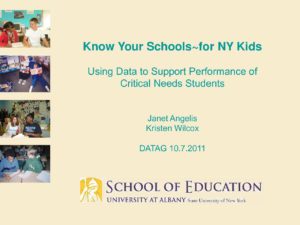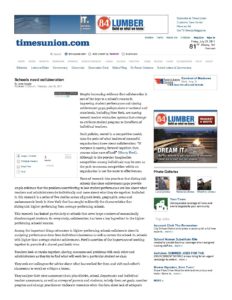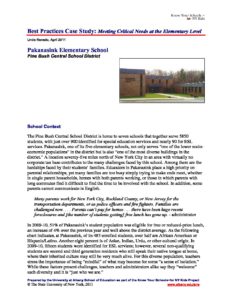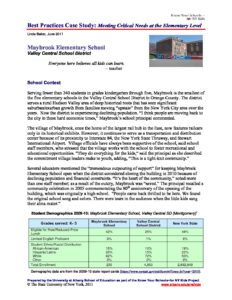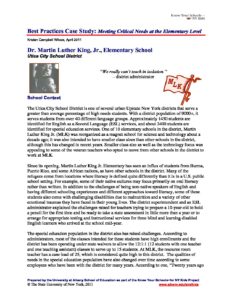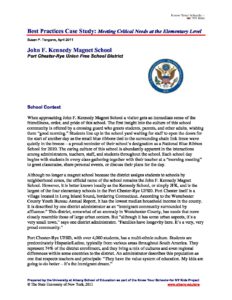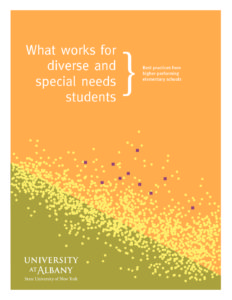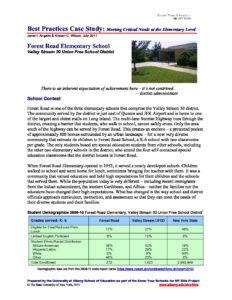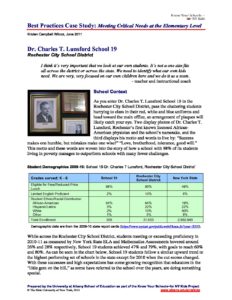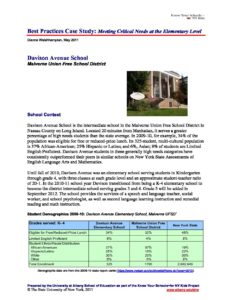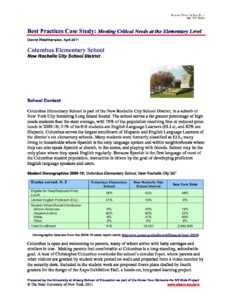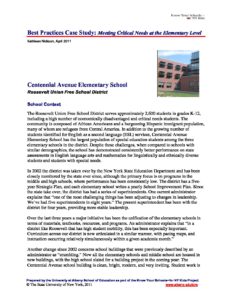Publication Year: 2011
This presentation describes the best practices used by schools in working with critical needs students. These practices include: (1) close engagement with and understanding of young people with critical needs; (2) literacy-and technology-enriched instruction; and (3) fluid adaptation and deployment of resources.
This presentation describes the best practices used by schools in working with critical needs students. These practices include: (1) close engagement with and understanding of young people with critical needs; (2) literacy-and technology-enriched instruction; and (3) fluid adaptation and deployment of resources.
Evidence indicates that collaboration is one of the keys to a school’s success in improving student performance and closing achievement gaps, though policymakers at the national and state levels, including New York, are moving toward teacher evaluation systems that attempt to attribute student progress to the efforts of individual teachers.
Evidence indicates that collaboration is one of the keys to a school’s success in improving student performance and closing achievement gaps, though policymakers at the national and state levels, including New York, are moving toward teacher evaluation systems that attempt to attribute student progress to the efforts of individual teachers.
This case study is part of an investigation of critical needs elementary schools during the 2010-11 school year.
This case study is one of a series of studies conducted by Know Your Schools~for NY Kids since 2005. For the study of critical needs elementary schools, conducted during the 2010-11 school year, research teams investigated ten consistently higher-performing and five consistently average-performing elementary schools. Schools were selected based on the performance of critical needs subgroups – African American, Hispanic, English language learners, and special education students, and students living in poverty as measured by eligibility for free or reduced-price lunch – on New York State Assessments of English Language Arts and Mathematics for grades 3 through 4, 5, or 6 in 2007, 2008, and 2009.
This case study is part of an investigation of critical needs elementary schools during the 2010-11 school year.
This case study is one of a series of studies conducted by Know Your Schools~for NY Kids since 2005. For the study of critical needs elementary schools, conducted during the 2010-11 school year, research teams investigated ten consistently higher-performing and five consistently average-performing elementary schools. Schools were selected based on the performance of critical needs subgroups – African American, Hispanic, English language learners, and special education students, and students living in poverty as measured by eligibility for free or reduced-price lunch – on New York State Assessments of English Language Arts and Mathematics for grades 3 through 4, 5, or 6 in 2007, 2008, and 2009.
This case study is part of an investigation of critical needs elementary schools during the 2010-11 school year.
This case study is one of a series of studies conducted by Know Your Schools~for NY Kids since 2005. For the study of critical needs elementary schools, conducted during the 2010-11 school year, research teams investigated ten consistently higher-performing and five consistently average-performing elementary schools. Schools were selected based on the performance of critical needs subgroups – African American, Hispanic, English language learners, and special education students, and students living in poverty as measured by eligibility for free or reduced-price lunch – on New York State Assessments of English Language Arts and Mathematics for grades 3 through 4, 5, or 6 in 2007, 2008, and 2009.
This case study is part of an investigation of critical needs elementary schools during the 2010-11 school year.
This case study is one of a series of studies conducted by Know Your Schools~for NY Kids since 2005. For the study of critical needs elementary schools, conducted during the 2010-11 school year, research teams investigated ten consistently higher-performing and five consistently average-performing elementary schools. Schools were selected based on the performance of critical needs subgroups – African American, Hispanic, English language learners, and special education students, and students living in poverty as measured by eligibility for free or reduced-price lunch – on New York State Assessments of English Language Arts and Mathematics for grades 3 through 4, 5, or 6 in 2007, 2008, and 2009.
This case study is part of an investigation of critical needs elementary schools during the 2010-11 school year.
This case study is one of a series of studies conducted by Know Your Schools~for NY Kids since 2005. For the study of critical needs elementary schools, conducted during the 2010-11 school year, research teams investigated ten consistently higher-performing and five consistently average-performing elementary schools. Schools were selected based on the performance of critical needs subgroups – African American, Hispanic, English language learners, and special education students, and students living in poverty as measured by eligibility for free or reduced-price lunch – on New York State Assessments of English Language Arts and Mathematics for grades 3 through 4, 5, or 6 in 2007, 2008, and 2009.
For the study of critical needs elementary schools, conducted during the 2010-11 school year, research teams investigated ten consistently higher-performing and five consistently average-performing elementary schools.
This case study is one of a series of studies conducted by Know Your Schools~for NY Kids since 2005. For the study of critical needs elementary schools, conducted during the 2010-11 school year, research teams investigated ten consistently higher-performing and five consistently average-performing elementary schools. Schools were selected based on the performance of critical needs subgroups – African American, Hispanic, English language learners, and special education students, and students living in poverty as measured by eligibility for free or reduced-price lunch – on New York State Assessments of English Language Arts and Mathematics for grades 3 through 4, 5, or 6 in 2007, 2008, and 2009.
This case study is part of an investigation of critical needs elementary schools during the 2010-11 school year.
This case study is one of a series of studies conducted by Know Your Schools~for NY Kids since 2005. For the study of critical needs elementary schools, conducted during the 2010-11 school year, research teams investigated ten consistently higher-performing and five consistently average-performing elementary schools. Schools were selected based on the performance of critical needs subgroups – African American, Hispanic, English language learners, and special education students, and students living in poverty as measured by eligibility for free or reduced-price lunch – on New York State Assessments of English Language Arts and Mathematics for grades 3 through 4, 5, or 6 in 2007, 2008, and 2009.
This case study is part of an investigation of critical needs elementary schools during the 2010-11 school year.
This case study is one of a series of studies conducted by Know Your Schools~for NY Kids since 2005. For the study of critical needs elementary schools, conducted during the 2010-11 school year, research teams investigated ten consistently higher-performing and five consistently average-performing elementary schools. Schools were selected based on the performance of critical needs subgroups – African American, Hispanic, English language learners, and special education students, and students living in poverty as measured by eligibility for free or reduced-price lunch – on New York State Assessments of English Language Arts and Mathematics for grades 3 through 4, 5, or 6 in 2007, 2008, and 2009.
This case study is part of an investigation of critical needs elementary schools during the 2010-11 school year.
This case study is one of a series of studies conducted by Know Your Schools~for NY Kids since 2005. For the study of critical needs elementary schools, conducted during the 2010-11 school year, research teams investigated ten consistently higher-performing and five consistently average-performing elementary schools. Schools were selected based on the performance of critical needs subgroups – African American, Hispanic, English language learners, and special education students, and students living in poverty as measured by eligibility for free or reduced-price lunch – on New York State Assessments of English Language Arts and Mathematics for grades 3 through 4, 5, or 6 in 2007, 2008, and 2009.
This case study is part of an investigation of critical needs elementary schools during the 2010-11 school year.
This case study is one of a series of studies conducted by Know Your Schools~for NY Kids since 2005. For the study of critical needs elementary schools, conducted during the 2010-11 school year, research teams investigated ten consistently higher-performing and five consistently average-performing elementary schools. Schools were selected based on the performance of critical needs subgroups – African American, Hispanic, English language learners, and special education students, and students living in poverty as measured by eligibility for free or reduced-price lunch – on New York State Assessments of English Language Arts and Mathematics for grades 3 through 4, 5, or 6 in 2007, 2008, and 2009.
This case study is part of an investigation of critical needs elementary schools during the 2010-11 school year.
This case study is one of a series of studies conducted by Know Your Schools~for NY Kids since 2005. For the study of critical needs elementary schools, conducted during the 2010-11 school year, research teams investigated ten consistently higher-performing and five consistently average-performing elementary schools. Schools were selected based on the performance of critical needs subgroups – African American, Hispanic, English language learners, and special education students, and students living in poverty as measured by eligibility for free or reduced-price lunch – on New York State Assessments of English Language Arts and Mathematics for grades 3 through 4, 5, or 6 in 2007, 2008, and 2009.

